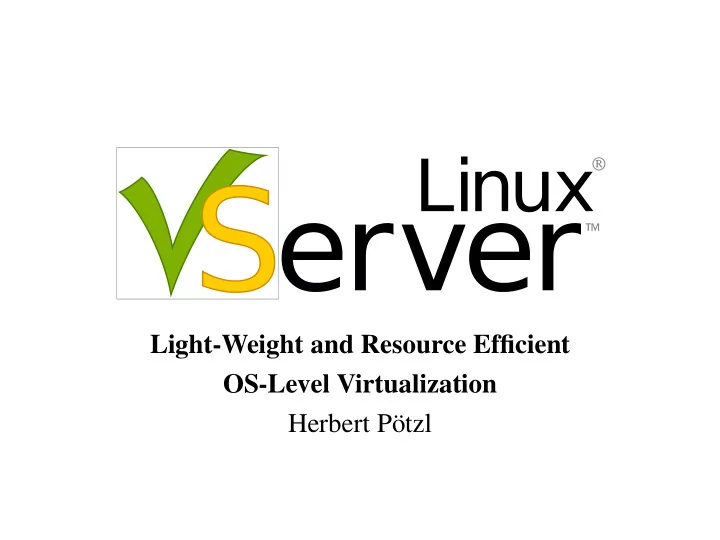

Light-Weight and Resource Efficient OS-Level Virtualization Herbert Pötzl
� 2004-2008 c Linux-VServer .org Herbert Pötzl 1 Introduction Computers have become sufficiently powerful to use virtualization to create the illusion of many smaller virtual machines, each running a separate operating system instance. ➠ Virtual Machines ➠ System Emulators ➠ Partitioning slide 2 created with L A T EX
� 2004-2008 c Linux-VServer .org Herbert Pötzl 2 The Concept Virtual Servers do not necessarily require a separate operating system for each instance Resources directly map to money – more servers require more CPU power, RAM, disk space, network bandwith and general I/O throughput. Isolation allows to put several Servers on a Host, which will share the available resources efficiently. slide 3 created with L A T EX
� 2004-2008 c Linux-VServer .org Herbert Pötzl 2.1 Advantages ✘ Minimal Overhead ✘ Hardware Abstraction ✘ Shared Resources 2.2 Possible Drawbacks ✘ Kernel as Single Point of Failure? ✘ Kernel Security Issues? slide 4 created with L A T EX
� 2004-2008 c Linux-VServer .org Herbert Pötzl 3 Nomenclature Host: the real or virtual machine running the Linux-VServer enabled Kernel. Guest: the virtual private server (or short VPS) composed of a chrooted environment, isolated processes, and restricted IP ranges. Context: the isolated and partially virtualized environment to which processes are confined . slide 5 created with L A T EX
� 2004-2008 c Linux-VServer .org Herbert Pötzl 4 Project History Jul. 2001 first public release Oct. 2001 Rik van Riel shows interest Nov. 2001 new Immutable-Linkage-Invert flag Jan. 2002 chroot exploit and barrier idea Jul. 2002 Herbert Pötzl suggests context quota Jul. 2003 Sam Vilain suggests ’going mainline’ Sep. 2003 Change of Project Maintainership Mar. 2004 First Pre-Release for 2.6.x May. 2004 First Devel Release (1.9.0) for 2.6 Aug. 2005 First Stable Release (2.0) for 2.6 slide 6 created with L A T EX
� 2004-2008 c Linux-VServer .org Herbert Pötzl 5 Isolation vs. Virtualization ★ IP Layer Network Isolation ...instead of Virtual Network Stacks ★ Namespaces and Shared Partitions ...instead of Virtual Filesystems ★ Accounting , Limits , and TB Scheduling ...instead of vResources and vCPUs slide 7 created with L A T EX
� 2004-2008 c Linux-VServer .org Herbert Pötzl 5.1 Lightweight Guests Isolation allows to have very small Guests (down to a single process) without creating measurable overhead. 5.2 Shared Services Isolation areas can overlap (to some extend) and services can be shared between Guests slide 8 created with L A T EX
� 2004-2008 c Linux-VServer .org Herbert Pötzl 5.3 Flexible Resources Because there is a common pool of Resources, and no static allocation to the Guests, they can be easily ... ✘ adjusted and shared ✘ monitored on the Host System ✘ limited or extended slide 9 created with L A T EX
� 2004-2008 c Linux-VServer .org Herbert Pötzl 6 Optional Virtualizations ✘ Init PID(1) [pstree, init] ✘ Network Interface Information ✘ Memory Information [free, meminfo] ✘ Available Disk Space [df] ✘ System Uptime [guest start] ✘ System Load [guest processes] ✘ System Time [adjustable] slide 10 created with L A T EX
� 2004-2008 c Linux-VServer .org Herbert Pötzl 7 Field of Application ✘ Virtual Server Hosting ✘ Administrative Separation ✘ Service Separation ✘ Enhancing Security ✘ Easy Maintenance ✘ Fail-over Scenarios ✘ Simplified Testing slide 11 created with L A T EX
� 2004-2008 c Linux-VServer .org Herbert Pötzl 8 Existing Infrastructure ✘ Linux Capability System ✘ Resource Limits (ulimit) ✘ File Attributes (xattr) ✘ The chroot(1) Command ✘ Private Namespaces slide 12 created with L A T EX
� 2004-2008 c Linux-VServer .org Herbert Pötzl 9 Required Modifications ✘ Context Separation ✘ Network Separation ✘ The Chroot Barrier ✘ Upper Bound for Caps ✘ Resource Isolation ✘ Filesystem XID Tagging slide 13 created with L A T EX
� 2004-2008 c Linux-VServer .org Herbert Pötzl 10 Additional Modifications ✘ Context Flags ✘ Context Capabilities ✘ Context Accounting ✘ Context Limits ✘ Virtualization ✘ Improved Security ✘ Kernel Helper slide 14 created with L A T EX
� 2004-2008 c Linux-VServer .org Herbert Pötzl 11 Features and Bonus Material ✘ Unification ✘ CoW Link Breaking ✘ The Linux-VServer Proc-FS ✘ TB Per CPU Scheduler ✘ Context Disk Limits ✘ Context Quota and VRoot Proxy ✘ Information Isolation slide 15 created with L A T EX
� 2004-2008 c Linux-VServer .org Herbert Pötzl 12 Intrusiveness patch lines chars hunks new vs1.00 2845 95567 178 997 vs1.20 4305 131922 216 1857 vs2.00 19673 557988 856 8987 vs2.01 20300 572752 898 9362 vs2.02 21330 602493 977 9464 vs2.1.0 25948 759709 1222 10394 vs2.2.0 27857 790256 1218 12989 openvz-2.6.22 122567 3384793 3654 73781 patch-2.6.23 ∆ 1072513 31824779 32650 359297 slide 16 created with L A T EX
� 2004-2008 c Linux-VServer .org Herbert Pötzl 13 Non Intel x86 Hardware ✔ ia64, x86_64 ✔ alpha, arm ✔ hppa, hppa64 ✔ ppc, ppc64 ✔ sparc, sparc64 ✔ mips o/n32, mips64 ✔ s390, s390x ✔ um, xen slide 17 created with L A T EX
� 2004-2008 c Linux-VServer .org Herbert Pötzl Q & A www: http://linux-vserver.org irc: #vserver @ irc.oftc.net slide 18 created with L A T EX
Recommend
More recommend